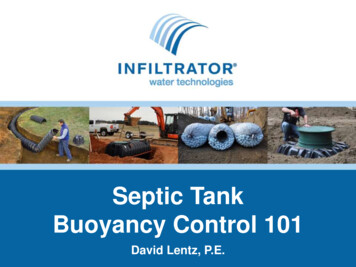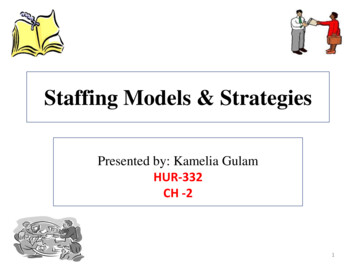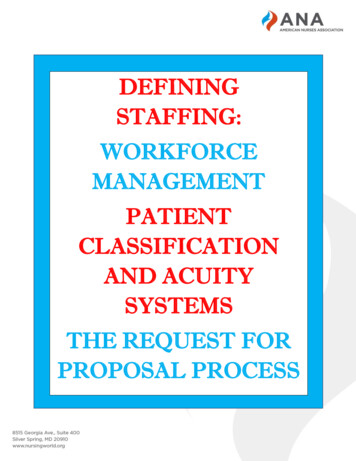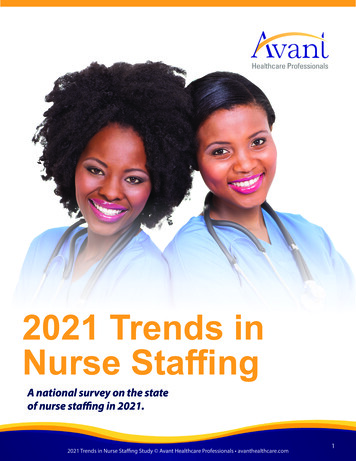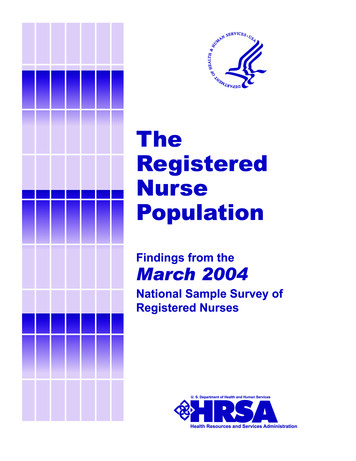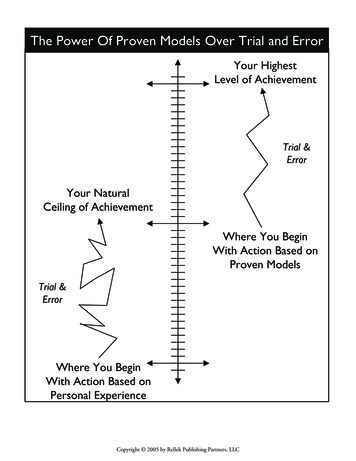
Transcription
Nurse Staffing Think Tank:Priority Topics and RecommendationsForewordThe nurse staffing crisis has no simple fix. Research shows that optimized nursestaffing is integral to high-level patient care, better patient/family experiencesand nurse well-being. Adequate investment in appropriate nurse staffing is alsoessential to a health care institution’s performance, reputation and financialviability. However, prevailing approaches to deploying nursing resources are notfully realizing the benefits of appropriate staffing. This is an urgent, high-stakespatient safety issue that represents a health care system imperative—not simplya nursing one—that must be tackled in new and bold ways. Nurse staffing isa complex process that is affected by the health of the work environment andchanges in the workforce, including nursing shortages, turnover and nursecompetencies. Additionally, the economic pressures on the health care systempose challenges to appropriate staffing.PrefaceIn light of these challenges and opportunities, a group of organizations cametogether in 2018 to form the Partners for Nurse Staffing in a collaborativeeffort to explore new solutions for nurse staffing issues. This group includesrepresentatives from the following organizations:The Partners for Nurse Staffing is focusing on ideas that maximize theinvestment in nurse staffing while creating the greatest value for patients,families, interprofessional health care teams, hospitals and payers. Theobjectives of the coalition are: American Association of Critical-Care Nurses (AACN) Elevate awareness of the evidence-based link between appropriate nursestaffing and optimal patient care, as well as links to better patient experience,a thriving nurse workforce and optimizing the value of care. American Nurses Association (ANA) American Organization for Nursing Leadership (AONL) Healthcare Financial Management Association (HFMA) Institute for Healthcare Improvement (IHI) 2022, Partners for Nurse Staffing Think Tank Identify and promote examples of staffing successes. Incubate bold innovations and transformative approaches.1
NURSE STAFFING THINK TANK: PRIORITY TOPICS AND RECOMMENDATIONSPreface (continued)The National Nurse Staffing Task Force (launching in Spring 2022) and Think Tankaim to provide a forum for powerful dialogue that will develop recommendations on anational scale to address critical challenges related to the nurse staffing crisis that haveplagued the profession for decades. The Task Force, consisting of stakeholders, subjectmatter experts (internal and external to nursing), and patient and family advocates,will focus on the acute and critical care setting during the initial phase of the work. TheTask Force will work over a nine-month period to develop innovative strategies thatwill address longer-term, complex and persistent systemic issues in nurse staffing.Executive SummaryOn January 11, 2022, the Partners for Nurse Staffing, a collaboration of fiveprofessional organizations, launched the Nurse Staffing Think Tank. Chargedwith identifying recommendations to address the nurse staffing crisis within a12-18 month implementation timeframe, the group met every other week fora total of six meetings. The first meetings focused on identifying high-priorityareas. Subsequent work conducted in small groups identified recommendationswithin each high-priority area, as well as action items and measurableThink TankPurposeoutcomes. The target audience for this work includes nurses, health careleaders and policymakers. The result of this work provides an action plan forthe necessary cultural shift in health care delivery that can drive improvednurse retention, healthier work environments and better patient outcomes. Therecommendations described here are actionable for health system and hospitalleaders. Actions under the category, “Healthy Work Environment,” also pertainto regulatory bodies, policymakers and specialty nursing organizations.The American Association of Critical-Care Nurses (AACN), American Nurses Association (ANA), American Organization for Nursing Leadership(AONL), Healthcare Financial Management Association (HFMA) and the Institute for Healthcare Improvement (IHI) launched a nurse staffingthink tank to find solutions to the nurse staffing crisis. The Think Tank brings together nurses, leaders and other stakeholders. As a collective,the Think Tank worked over three months to develop actionable strategies set to implement within 12-18 months with measurable outcomesthat will address the nurse staffing crisis. This work sets the foundational work for a Nurse Staffing Task Force scheduled to launch in Spring2022 by providing: Strategic advice on broad ideas and direction based on data that identifies the root causes of the nursing shortage Input on workforce trends, challenges and issues hindering progress toward feasible and practical staffing solutions Strategic direction for broader goals Options for action, including associated outcomescontinues 2022, Partners for Nurse Staffing Think Tank2
NURSE STAFFING THINK TANK: PRIORITY TOPICS AND RECOMMENDATIONSExecutive Summary (continued)Think TankParticipants andRepresentativesfrom OrganizationalPartners for NurseStaffingThink Tank ParticipantsRepresentatives from Organizational Partners for Nurse Staffing Janet Ahlstrom, University of Kansas Medical Center Connie Barden, AACN Carol Boston-Fleischhauer, The Advisory Board Robyn Begley, AONL Danielle Bowie, Bon Secours Mercy Health Katie Boston-Leary, ANA Natalia Cineas, NYC Health Hospitals Linda Cassidy, AACN Pamela Cipriano, University of Virginia, International Council of Nurses Wendy Cross, AACN Amber Clayton, Society for Human Resource Management Sarah Delgado, AACN Vanessa Dawkins, NewYork-Presbyterian/Weill Cornell Medical Centerand NewYork-Presbyterian Westchester Behavioral Health Center Patricia McGaffigan, IHI Vicki Good, Mercy Health Melinda Hancock, Sentara Healthcare April Hansen, Aya Healthcare Group Kendra McMillan, ANA Todd Nelson, HFMA Cheryl Peterson, ANA Helen Haskell, Mothers Against Medical Error Kiersten Henry, MedStar Montgomery Medical Center Peggy Lee, VA of Southern Nevada and Nevada Action Coalition Ryan Miller, ChristianaCare Health System Sherry Perkins, Luminis Health Anne Arundel Medical Center Larry Punteney, Avantas Rosanne Raso, NewYork-Presbyterian Weill Cornell Medical Center David Tam, Beebe Healthcare Sarah Wells, Acute care nurse and Founder, New Thing NurseSpecial Contributor for Diversity, Equity and Inclusion,and Inclusive Excellence: Rumay AlexanderThe Partners for Nurse Staffing wish to thank Regina Black-Lennox, the Satell Institute, for serving as the group facilitator, and Karen Thomasand Melissa Jones for their editorial expertise.continues 2022, Partners for Nurse Staffing Think Tank3
NURSE STAFFING THINK TANK: PRIORITY TOPICS AND RECOMMENDATIONSExecutive Summary (continued)Overview ofPriority Topics andRecommendationsHealthy WorkEnvironment Elevate clinician psychological and physical safety to equal importance with patient safety through federal regulation. Specialty nursing organizations should investigate evidence related to scope of practice and minimum safe staffinglevels for patients in their specialty.Diversity, Equityand Inclusion (DEI) Implement Inclusive Excellence, a change-focused iterative planning process whereby there is deliberateintegration of DEI ideals into leadership practices, daily operations, strategic planning, decision-making, resourceallocation and priorities.Work ScheduleFlexibility Build a flexible workforce with flexible scheduling, flexible shifts and flexible roles.Stress InjuryContinuum Address burnout, moral distress, and compassion fatigue as barriers to nurse retention. Incorporate well-being of nurses as an organizational value.Innovative CareDelivery Models Implement tribrid care delivery models that offer a holistic approach with three components, including onsite caredelivery, IT integration of patient monitoring equipment, and ambulatory access and virtual/remote care delivery.This approach will improve access, patient and staff experience, and resource management, with continuousmeasurement for improvement and adjustment for sustainability and support.Total Compensation Develop an organization-wide formalized and customizable total compensation program for nurses that isstratified based on market intelligence, generational needs and an innovative and transparent pay philosophy thatis inclusive of benefits such as paid time off for self-care and wellness and wealth planning for all generations.Suggested citation: Partners for Nurse Staffing Think Tank. (2022). Nurse Staffing Think Tank: Priority Topics and Recommendations. 2022, Partners for Nurse Staffing Think Tank4
NURSE STAFFING THINK TANK: PRIORITY TOPICS AND RECOMMENDATIONSHealthy Work EnvironmentOperational definition: A healthy work environment is safe, healing, humane, and respectful of the rights, responsibilities, needs and contributions of all peopleincluding patients, their families, nurses and other health care professionals. In these environments, nurses and other team members can provide their optimalcontribution and derive fulfillment from their work and patients can achieve the best possible outcomes.Recommended action for policymakers and health system leaders:Elevate clinician psychological and physical safety to equal importance with patient safety through federal regulation.DefinitionWorkplace violence: Address physical safetyWork environment: Ensure psychological safetyNurses’ hazards include: Psychological safety may be defined as the ability to be oneselfwithout fear of negative consequences. Lifting and moving patients Handling sharps; chemical, radiation or infectious exposures Chronic stress from high-stakes work Workplace violenceTargetsClinician physical safety in work environment In a psychologically safe environment, teams feel thatinterpersonal risk-taking is safe. Incivility, bullying and lateral violence are not tolerated. Health care teams Health care leadersScope ofimpactEvery U.S. acute, critical access and long-term care hospitalNational impact via federal regulation; institutional impact ifadopted by leadersAccountableentities Health care leaders and health systems Centers for Medicare & Medicaid Services (CMS) Professional nursing organizations to advocate for policy/regulatory change Health systems Federal government Federal and state policymakers and regulators to codifyworkplace violence tracking and prevention Health care leaders for institutional implementationWithin 12 monthsWithin 12-18 monthsTimeline Professional nursing organizations for advocacycontinues 2022, Partners for Nurse Staffing Think Tank5
NURSE STAFFING THINK TANK: PRIORITY TOPICS AND RECOMMENDATIONSHealthy Work Environment (continued)MeasurableoutcomesWorkplace violence: Address physical safetyWork environment: Ensure psychological safety Decrease in rates of physical violence against health careprofessionals in the organization Implement a process for routinely measuring the health of thework environment. Implementation of federal legislation and/or CMS regulationthat requires health care facilities to track workplace violence andto put in place measures to ensure the physical safety of theiremployees (regular and contracted) Implement a quality control process for acting on data about thework environment to move toward improvement. Decrease in Workers’ Compensation claims for violence Implement a CMS Condition of Participation that addresses thehealth of the work environment. Collect unit-level data on the safety of the work environment routinelyon a quarterly basis and use the data to drive needed change. Collect, stratify and report data on workplace safety and harms(physical and nonphysical) to assess equity in the work environment.Action steps/Steps towardimplementation Implement processes to track and prevent workplace violencewithin health systems. Develop and enforce anti-violence principles, policies andprocesses for employee protection on an organizational level. Enact federal legislation and CMS regulations to protect and giveemployees a bold voice against physical violence in the workplace(with exemptions to be specified for patients with illness-relateddelirium and other organic processes). Discuss with CMS Deputy Administrator. Advocate for implementation of federal legislation to protecthealth care professionals. Advocate for clinician experience as a criterion in the CMS HospitalValue-Based Purchasing program (mirroring patient experience). Advocate to create a CMS Condition of Participation that requiresorganizations to regularly assess/measure the health of the workenvironment and demonstrate evidence of continual improvement. Advocate for implementation of a standard or Condition ofParticipation by CMS requiring that hospitals protect health careprofessionals. Consider using the Quadruple Aim as a framework for equatingpatient and professional safety.Supportingevidence Dyer O. U.S. hospitals tighten security as violence against staffsurges during pandemic BMJ 2021; 375:n2442 OSHA. 2016 report on healthcare workplace violence. U.S. Bureau of Labor Statistics. Fact Sheet on Workplace Violencein Healthcare. Aiken, L. H., Cimiotti, J. P., Sloane, D. M., Smith, H. L., Flynn, L., &Neff, D. F. (2012). “Effects of nurse staffing and nurse education onpatient deaths in hospitals with different nurse work environments,”The Journal of Nursing Administration, 42(10 Suppl), S10–S16. American Association of Critical-Care Nurses. Standards forEstablishing and Sustaining Healthy Work Environments. Clark, T. R. (2020). The 4 stages of psychological safety: Defining thepath to inclusion and innovation. Berrett-Koehler Publishers. 2022, Partners for Nurse Staffing Think Tank6
NURSE STAFFING THINK TANK: PRIORITY TOPICS AND RECOMMENDATIONSHealthy Work Environment (continued)Recommended action for specialty nursing organizations:Investigate evidence related to scope of practice and minimum safe staffing levels for patients in their specialty.Topic Investigation of minimum safe staffing levels for specific patient populations Development of staffing standards to address the needs of patients in specialty populationsDefinition Similar to the role professional organizations take in defining “scope and standards of practice” for nurses, there is a role to defineappropriate staffing. Staffing standards are defined according to patient needs and existing evidence that correlates staffing levels and patient outcomes.The standards include consideration for the range of patient acuity and skill mix available in different organizations.TargetsSpecialty nursing organizations, direct care nurses and nursing leadersScope of impactNational impactAccountable entitiesSpecialty nursing organizationsTimeline Six months for investigation of minimum staffing levels Twelve months for development of staffing standardsMeasurableoutcomes Specialty organizations:— Assess applicability and report that they have undertaken this work within six months— Define staffing standards for patients in their specialtyAction steps/Steps towardimplementation Nursing specialty organizations investigate evidence related to scope of practice and minimum safe staffing levels for the specialty. Organizations play a role in creating standards that delineate staffing requirements for optimal care. Organizations apply a process that engages key stakeholders, including direct care nurses, in the development of staffing standards. Consider using the work of other specialty organizations, such as AWHONN, that have created staffing standards as exemplars.Supportingevidence Aiken, L. H., Cerón, C., Simonetti, M., Lake, E. T., Galiano, A., Garbarini, A., Soto, P., Bravo, D., & Smith, H. L. (2018). Hospital nurse staffing andpatient outcomes. Revista Médica Clínica Las Condes, 29(3), 322–327. Ball, J. E., Bruyneel, L., Aiken, L. H., Sermeus, W., Sloane, D. M., Rafferty, A. M., Lindqvist, R., Tishelman, C., & Griffiths, P. (2018). Post-operativemortality, missed care and nurse staffing in nine countries: A cross-sectional study. International Journal of Nursing Studies, 78, 10–15. Lasater, K. B., Sloane, D. M., McHugh, M. D., Cimiotti, J. P., Riman, K. A., Martin, B., Alexander, M., & Aiken, L. H. (2021). Evaluation of hospitalnurse-to-patient staffing ratios and sepsis bundles on patient outcomes. American Journal of Infection Control, 49(7), 868–873. McHugh, M. D., Rochman, M. F., Sloane, D. M., Berg, R. A., Mancini, M. E., Nadkarni, V. M., Merchant, R. M., & Aiken, L. H. (2016). Better nursestaffing and nurse work environments associated with increased survival of in-hospital cardiac arrest patients. Medical Care, 54(1), 74–80. 2022, Partners for Nurse Staffing Think Tank7
NURSE STAFFING THINK TANK: PRIORITY TOPICS AND RECOMMENDATIONSDiversity, Equity and InclusionOperational definition: Nurse leaders have a responsibility to address structural racism, culturalracism and discrimination based on identity (e.g., sexual orientation, gender), place (e.g., rural,urban), and circumstances (e.g., disability, mental health condition) within the nursing professionand to help build structures and systems at the societal level that address these issues to promotehealth equity. This definition of Inclusive Excellence describes a change-focused iterative planningprocess whereby there is deliberate integration of diversity, equity and inclusion (DEI) ideals intoleadership practices, daily operations, strategic planning, decision-making, resource allocation andpriorities. It also states that the work is about change and therefore requires constant, innovativeways to have a diverse workforce. This definition shuts down the typical comments of loweringquality in order to achieve diversity (Williams, Berger, McClendon, 2005).Building a diverse nursing workforce is a critical part of preparing nurses to address socialdeterminants of health (SDOH) and health equity. While the nursing workforce has steadily grownmore diverse, nursing schools need to continue and expand their efforts to recruit and supportdiverse students that reflect the populations they will serve. Diversity and inclusion is evidentiallylinked to psychological safety, which in turn has an impact on retention.Access &SuccessOrganizationalInfrastructureTraining te &IntergroupRelationsCommunityEngagementRecommended action for leaders of health systems and hospitals: Implement Inclusive Excellence, a change-focused iterative planning process whereby thereis deliberate integration of diversity, equity and inclusion ideals into leadership practices, daily operations, strategic planning, decision-making, resource allocationand priorities. Diverse includes diversity in sexual orientation, gender, race, ethnicity, and physical and psychological ability.DefinitionIncrease diversity innursing leadershipBuild a diversenursing workforceInclusive Excellence is a changefocused iterative planning processwhereby there is deliberateintegration of diversity, equity andinclusion ideals into leadershippractices, daily operations, strategicplanning, decision-making,resource allocation and priorities.Diverse workforce is a criticalpart of preparing nurses toaddress SDOH and health equity.Provide psychologicalsafety to attract/retaina diverse workforcePsychological safety is linked todiversity, equity and inclusion.Four stages include inclusionsafety, learner safety, contributorsafety and challenger safety.Establish a nursingdiversity dashboardA nursing diversity dashboardtracks workforce demographicsand measures alignment with thecommunity, state and nation.continues 2022, Partners for Nurse Staffing Think Tank8
NURSE STAFFING THINK TANK: PRIORITY TOPICS AND RECOMMENDATIONSDiversity, Equity and Inclusion (continued)TargetsIncrease diversity innursing leadershipBuild a diversenursing workforceProvide psychologicalsafety to attract/retaina diverse workforceEstablish a nursingdiversity dashboardNurse leadersDirect care nursing staffHealth care workforce Nursing Nursing leadership C-suiteScope ofimpact Managers Patients Directors Nurses Administrators Schools of nursing C-suite FacultyHealth care teamsHealth care teamsAccountableentities Nursing leadership Nursing leadership Nursing leadership Nursing leadership C-suite C-suite C-suite C-suiteTimeline12 months12 months12 months6 monthsMeasurableoutcomes Data dashboard of nursingleaders will show improvementin diversity within one year. Data dashboard of nursingworkforce will showimprovement in diversitywithin one year. Data measuring psychologicalsafety will show improvementwithin one year. Data dashboard will beavailable within six months. Dashboard should align withthe diversity in the populationserved by the facility. Dashboard should align withthe diversity in the populationserved by the facility.continues 2022, Partners for Nurse Staffing Think Tank9
NURSE STAFFING THINK TANK: PRIORITY TOPICS AND RECOMMENDATIONSDiversity, Equity and Inclusion (continued)Increase diversity innursing leadershipAction steps/Steps towardimplementation Nursing schools recruit and Review the leadership team.support diverse students thatDirect all current and upcomingreflect the populations theyvacancies to be diverse hireswill serve.(in accordance with labor lawsInclude the following inand human resources (HR)defining diversity: Gender,guidelines). Note that “diverseLGBTQ, BIPOC, ethnicity,hires” should be definedableism, psychiatric/mentalbeyond race/ethnicity.health/substance use. Monitor the speed and trendsat which underrepresentedgroups are hired and move upthe corporate ladder. Review turnover data for staffwho are Black, Indigenousand People of Color (BIPOC)and other underrepresentedgroups. Define diversity broadly.Specific groups mentioned inthe Think Tank, in addition toBIPOC, include gender (which,like race, is specifically notdiverse in nursing) LGBTQ,differently abled professionalsand those with substance usedisorders.SupportingevidenceBuild a diversenursing workforceMorrison, V., Hauch, R. R., Perez,E., Bates, M., Sepe, P., & Dans,M. (2021). Diversity, equity,and inclusion in nursing: ThePathway to Excellence frameworkalignment. Nursing AdministrationQuarterly, 45(4), 311-323. 2022, Partners for Nurse Staffing Think TankProvide psychologicalsafety to attract/retaina diverse workforce In orientation sessions, includecommitment to diversity andzero tolerance for assaults onanother’s self-esteem. Add a DEI category toperformance appraisals forannual goals for performanceranking tied to compensation. Embrace LPNs and ADNs as astrategy to diversify workforce.They must be treated andrespected similar to RNs.Support and respect theirdesire to pursue advanceddegrees.Establish a nursingdiversity dashboard Overall, nursing, nursingleadership, C-suite with yearlyimprovement: New hires,turnover (90 days, 6 months,1 year), and RN satisfaction. Be transparent with data.Develop meaningful DEIdashboards for staff andcommunity audiences.Webpage visibility of workforcedemographics and activitiesshould be no more than oneclick away. Institute diversity awards andpublicize demographics ofawardees for awards grantedwith award program.Gerull, K. M., Enata, N., Welbeck,A. N., Aleem, A. W., & Klein, S.E. (2021). Striving for inclusiveexcellence in the recruitment ofdiverse surgical residents duringCOVID-19. Academic Medicine,96(2), 210-212.Clark, T. R. (2020). The 4 stages ofpsychological safety: Defining thepath to inclusion and innovation.Berrett-Koehler Publishers.Williams, D. A., Berger, J. B., &McClendon, S. A. (2005). Towarda model of inclusive excellenceand change in postsecondaryinstitutions (p. 39). Washington,DC: Association of AmericanColleges and Universities.10
NURSE STAFFING THINK TANK: PRIORITY TOPICS AND RECOMMENDATIONSWork Schedule FlexibilityOperational definition: A staff scheduling approach that encompasses flexibility in work options, policies and scheduling with nurses cross trained to various units, tosupport well-being during a shift that incorporates time for professional development and leadership engagement such as shared governanceRecommended action for leaders of health systems and hospitals:Build a flexible workforce and flexible work environment with flexible scheduling, flexible shifts of variable start times and duration, and flexible roles.Site float poolMultihospitalsystem float poolSeasonal and surge PRNto full-time float poolInterdisciplinarycare teamDefinitionSingle entity, on-site float,i.e., hospital, clinic, floating tomultiple units within a specialtyor as cross trainedMultisite enterprise floatpool where appropriate in adefined geographical regionfor daily or long-term placementExpansion and contraction ofclinical and nonclinical workforceas needed to accommodatepredictable seasonal fluctuations(i.e., seasonal trends, geography,demographics of patientpopulation served) Retired workforce picking upassignments based on demand Per diem/part-time workforcepicking up full-timeassignments to bump up FTE 0.6 FTE who work 0.3 duringthe summer and 0.9 FTE Interdisciplinary team forshift-based tasks, e.g.,resource nurse, ancillarystaff, admissions, discharge,medication pass nurse, breaknurses, weekend coverage. etc. Staff in this category follownontraditional hours and shiftsto support peak volume andtasks and can be hired intofloat or nonfloat departments. Consideration is also givento use of support providedthrough virtual roles andresources.Targets Group of clinicians who float byspecialty within their scope ofpractice and competency andlicensure Group of clinicians who float byspecialty within their scope ofpractice and competency andlicensure. Highly skilled staffcross trained and oriented tomultiple units.Float: Group of clinicianswho float by specialty withintheir scope of practice andcompetency and licensure. Highlyskilled staff cross trained andoriented to multiple units.Float: Group of clinicianswho float by specialty withintheir scope of practice andcompetency and licensure. Highlyskilled staff cross trained andoriented to multiple units.Nonfloat: Group of cliniciansassigned to a dedicated unit topractice within their scope ofpractice and competency andlicensure.Nonfloat: Group of cliniciansassigned to a dedicated unitto practice within their scopeof practice and competencyand licensure. Also includesancillary staff. For the future, consider a floatpool comprising nonclinicalstaff for surges. This wasleveraged successfully duringthe COVID-19 pandemic.continues 2022, Partners for Nurse Staffing Think Tank11
NURSE STAFFING THINK TANK: PRIORITY TOPICS AND RECOMMENDATIONSWork Schedule Flexibility (continued)Scope ofimpactAccountableentitiesSite float poolMultihospitalsystem float poolSeasonal and surge PRNto full-time float poolInterdisciplinarycare team Patient care quality and safety Patient care quality and safety Patient care quality and safety Patient care quality and safety Staff satisfaction Staff satisfaction Staff satisfaction Staff satisfaction Cost Cost Cost Cost Management Management Management Management Nursing State boards of nursing tosupport compact licensure andmultistate practice, scope ofpractice State boards of nursing tosupport compact licensure andmultistate practice, scope ofpractice State boards of nursing tosupport compact licensure andmultistate practice, scope ofpractice Nursing Nursing Nursing Finance Finance Finance HR HR HR Hospital leadership Hospital leadership Hospital leadershipSix to 12 months for changemanagement, hiring, trainingand deploymentThree to six months for changemanagement, hiring, trainingand deploymentSix to 12 months for changemanagement, hiring, trainingand deployment Finance HR Hospital leadershipTimelineMeasurableoutcomesThree to six months for changemanagement, hiring, trainingand deployment Frontline employee engagement Patient experience Reduction in agency overtime Reduction in vacancy and turnover ratescontinues 2022, Partners for Nurse Staffing Think Tank12
NURSE STAFFING THINK TANK: PRIORITY TOPICS AND RECOMMENDATIONSWork Schedule Flexibility (continued)Action steps/Steps towardimplementationSite float poolMultihospitalsystem float poolSeasonal and surge PRNto full-time float poolInterdisciplinarycare team Do a cost analysis to build theprogram. (Review unit-levelspending to scope specialty toinclude premium and agencyspend.) Do a cost analysis to build theprogram. (Review unit-levelspending to scope specialty toinclude premium and agencyspend.) Understand workflow trendsand data to build flexibleschedules that will allow forcontinuity of patient care. Understand workflow trendsand data to build flexibleschedules that will allow forcontinuity of patient care. Build a job description. Build a job description. Review pay structure/totalcompensation and benefits. Review pay structure/totalcompensation and benefits. Set up organizational structurefor management. Set up organizational structurefor management. Develop education structure(orientation, competency). Develop education structure(orientation, competency). Upskill and cross train theworkforce. Upskill and cross train theworkforce. Provide education andchange management for theorganization about the newteam. Include organizationaldefinition of flexible workforceand definition of internalcontingency and float poolrules. Provide education andchange management for theorganization about the newteam. Include organizationaldefinition of flexible workforceand definition of internalcontingency and float poolrules. Define ways to deploy foroperational use.
a nursing one—that must be tackled in new and bold ways. Nurse staffing is a complex process that is affected by the health of the work environment and changes in the workforce, including nursing shortages, turnover and nurse competencies. Additionally, the economic pressures on the health care system pose challenges to appropriate staffing.


